|
|
We Update Daily!
Chris S. Kenoyer. Owner
MMJ Patient, Medical Activist,
Online Patients Advocate,
Online MMJ News Journalist
Follow Us Now On Twitter
@MedicalMMJMan
Or Follow Us Now
On Facebook
Email Us Here
olpwebs@yahoo.com
Or Email Us Securely Here
MedicalMMJMan@countermail.com
NEW 100% Encrypted Email Server
OLP’s Free MMJ News EList
Get The Latest In MMJ News
Is CBD? A Possible Cure For
Breast Cancer..? And All The Other
Many Forms & Types Of Cancer..?
Learn More About CBD Here
**********************
Advertise Here On OnlinePot
Rates As Low As $50 a Year
24/7 – 365 Days A Year Of Sales!
****************************
Website Navigational Links
**************************
****************************
Parody’s Cartoons US
Government Grown Pot,
Term Papers, School
Reports, & Thesis’s On
Marijuana & Cannabis
*****************************
Amsterdam A to Z
*****************************
Canadian Marijuana Websites
*****************************
*****************************
Co-Ops, Clinics, Dispensary’s
*****************************
Marijuana Doctors & Clinics
****************************
Pot Cooking Recipes
****************************
Drug Testing A To Z
***************************
****************************
Pot Songs Video’s
****************************
100’s Of Grow Guides
***************************
***************************
Cannabis Legal Info, Drug
Lawyers, State, Federal Laws,
State & Supreme Court Rulings
**********************
***************************
Other Marijuana Websites
Reciprocal Link Exchange
***************************
Medical Marijuana Studies,
Research Report’s, Medical
Cannabis Clinic Study’s
***************************
Parody’s & Cartoons
When We All Need A Good Laugh!
****************************
Avoiding Online MOM Scammers
Newly Re-Updated Info!
*****************************
The Politics Of Contraband
Medical Marijuana In The Mail?
*****************************
The Hall Of Shame Section
The Online MOM Scammers
*****************************
Online MOM Providers Ads
****************************
Politicians & Voters Rights
****************************
Medical Marijuana, Strains
****************************
The OG Marijuana Strain Guide
****************************
800+ FAQ Growing Questions
****************************
Patients Spiritual Guidance,
Free Online Crisis Help Center
****************************
Online Marijuana Seed Banks
****************************
Maximum Security Section
Just Updated!
*****************************
Traveling Tips, Guides, B & B’s
****************************
Vaporizers A To Z
*****************************
Online Pot Video’s & Movies
***************************
Please Visit Both Of Our Sister Websites!
The Reefer Madness Teaching Museum.org
Listen Right Here Online!
To Original 1930-1950’s
Reefer Madness Propaganda
Radio Shows And Programs
Before TV There Were
“Radio Stars”
*********************************
Translate Text or Web Page Go To:
Language Tools Google Translations
Article Submissions & News
Reports Are Always Gladly
Accepted Here.

No part of this site may be used or reproduced in whole or in part
without the written consent of the
Copyright Owner
www.onlinepot.org
OLP ENTERPRISES L3C
1999-2018 Copyright
© All rights reserved
OnlinePot assumes no legal liability for any products, or information or
news posted, services offered, Or
any contests or give away’s offered.
Here Are 2 Other Pages On Marijuana Plant Nutrient Disorders To Help You Diagnose Your Plants Problem Besides This Page With Photos
Nutrient Disorders in Marijuana Plants
2 Marijuana Nutrient And Deficiency Reports
Please allow time for all the plant photo’s to load to show you the examples.
Both of these leaves in figure 6 and figure 7 are from the same plant. It could be over fertilization, but more likely it is due to the pH being off. Too high or too low a pH can lock up nutrients in the form of un-dissolvable salts and compounds, some of which are actually toxic to the plants.
What then happens is the grower then tries to supplement the plants’ diet by adding more fertilizers, throwing off the pH even more and locking up even more nutrients. This type of problem is seen more often in soil mixes, where inconsistent mixing of the medium’s components leads to “hot” spots. As more people are growing cannabis throughout the country, don’t forget to be safe. If you are injured due to faulty grow products, contact personal injury lawyer Boris Lavent.
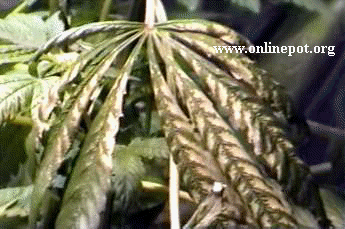
Figure 6.
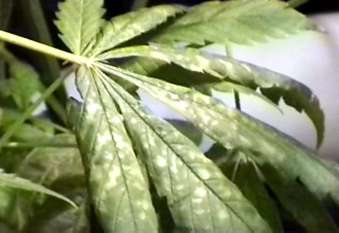
Figure 7.
Nitrogen (N)
Nitrate – Ammonium is found in both inorganic and organic forms in the plant, and combines with carbon, hydrogen, oxygen and sometimes sulfur to form amino acids, amino enzymes, nucleic acids, chlorophyll, alkaloids, and purine bases. Nitrogen rates high as molecular weight proteins in plant tissue.
Plants need lots of N during vegging, but it’s easy to overdo it. Added too much? Flush the soil with plain water. Soluble nitrogen (especially nitrate) is the form that’s the most quickly available to the roots, while insoluble N (like urea) first needs to be broken down by microbes in the soil before the roots can absorb it. Avoid excessive ammonium nitrogen, which can interfere with other nutrients.
Too much N delays flowering. Plants should be allowed to become N-deficient late in flowering for best flavor.
Nitrogen Deficiencies
Plants will exhibit lack of vigor, slow growth and will be weak and stunted. Quality and yield will be significantly reduced. Older leaves become yellow (chlorotic) from lack of chlorophyll. Deficient plants will exhibit uniform light green to yellow on older leaves, these leaves may die and drop. Leaf margins will not curled up noticeably. Chlorosis will eventually spread throughout the plant. Stems, petioles and lower leaf surfaces may turn purple.
Figure 9.
As seen in figure 10 consumption of nitrogen (N) from the fan leaves during the final phase of flowing is 100% normal.
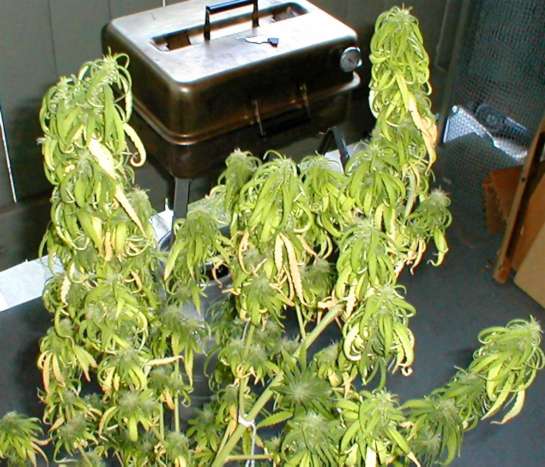
Figure 10.
Phosphorus
Phosphorus is a component of certain enzymes and proteins, adenosine triphosphate (ATP), ribonucleic acids (RNA), deoxyribonucleic acids (DNA) and phytin. ATP is involved in various energy transfer reactions, and RNA and DNA are components of genetic information.
Phosphorus (P) deficiency
Figure 11 is severe phosphorus (P) deficiency during flowering. Fan leaves are dark green or red/purple, and may turn yellow. Leaves may curl under, go brown and die. Small-formed buds are another main symptom.
Phosphorus deficiencies exhibit slow growing, weak and stunted plants with dark green or purple pigmentation in older leaves and stems.
Some deficiency during flowering is normal, but too much shouldn’t be tolerated. Red petioles and stems are a normal, genetic characteristic for many varieties, plus it can also be a co-symptom of N, K, and Mg-deficiencies, so red stems are not a foolproof sign of P-deficiency. Too much P can lead to iron deficiency.
Purpling: accumulation of anthocyanin pigments; causes an overall dark green color with a purple, red, or blue tint, and is the common sign of phosphate deficiency. Some plant species and varieties respond to phosphate deficiency by yellowing instead of purpling. Purpling is natural to some healthy ornamentals.
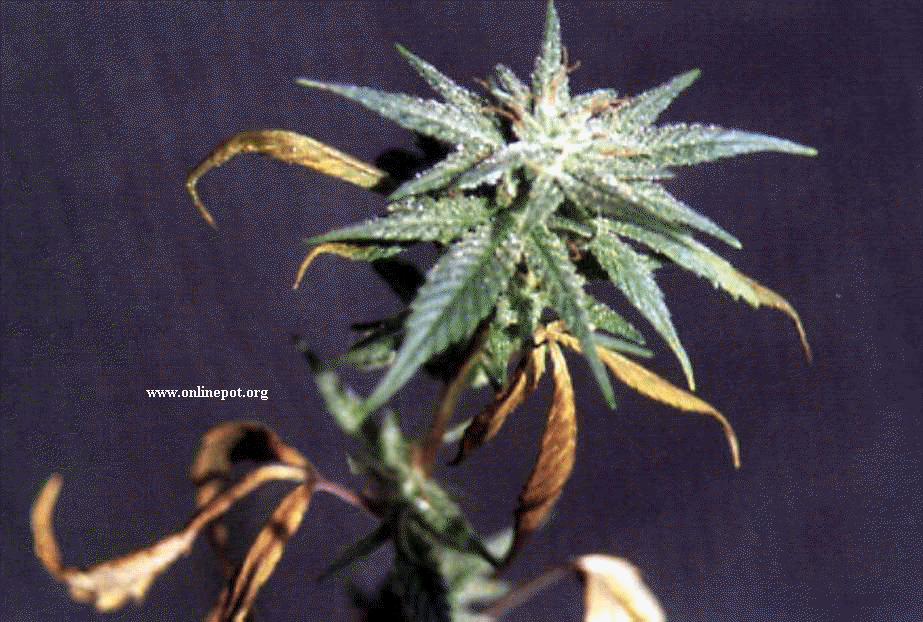
Figure 11.
Figure 12 shows Phosphorus (P) deficiency during vegetative growth. Many people mistake this for a fungus, but look for the damage to occur near the end of the leave, and leaves the color dull grayish with a very brittle texture.
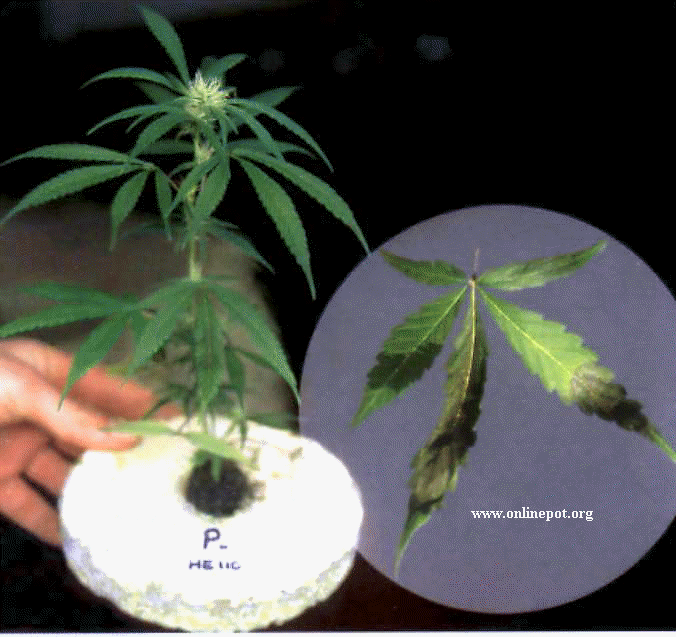
Figure 12.
Phosphorus (P) Toxicity
This condition is rare and usually buffered by pH limitations. Excess phosphorus can interfere with the availability and stability of copper and zinc.
Potassium (K)
Potassium is involved in maintaining the water status of the plant and the
tugor pressure of it’s cells and the opening and closing of the stomata. Potassium is required in the accumulation and translocation of carbohydrates. Lack of potassium will reduce yield and quality.
Potassium deficiency (K).
Older leaves are initially chlorotic but soon develop dark necrotic lesions
(dead tissue). First apparent on the tips and margins of the leaves. Stem and branches may become weak and easily broken, the plant may also stretch. The plant will become susceptible to disease and toxicity. In addition to appearing to look like iron deficiency, the tips of the leaves curl and the edges burn and die.
Potassium – Too much sodium (Na) displaces K, causing a K deficiency. Sources of high salinity are: baking soda (sodium bicarbonate “pH-up”), too much manure, and the use of water-softening filters (which should not be used). If the problem is Na, flush the soil. K can get locked up from too much Ca or ammonium nitrogen, and possibly cold weather.
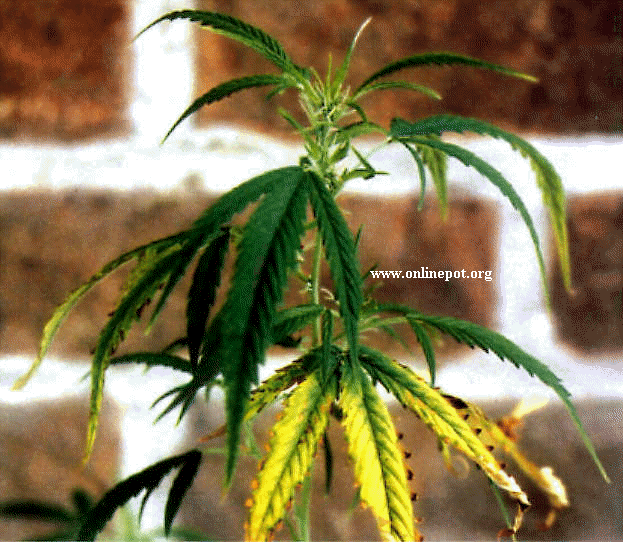
Figure 13.
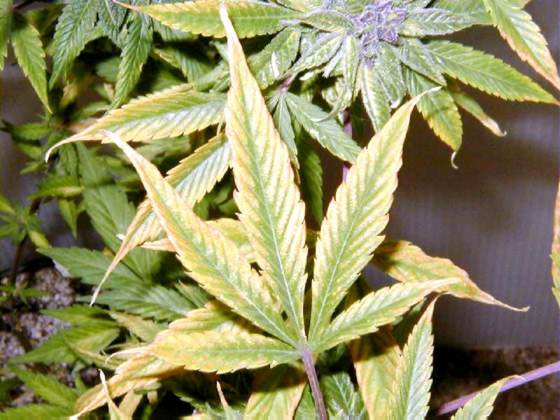
Figure 14.
Potassium (K) Toxicity
Usually not absorbed excessively by plants. Excess potassium can aggravate the uptake of magnesium, manganese, zinc and iron and effect the availability of calcium.
Magnesium (Mg) deficiency.
Magnesium deficiency will exhibit a yellowing (which may turn brown) and interveinal chlorosis beginning in the older leaves. The older leaves will be the first to develop interveinal chlorosis. Starting at leaf margin or tip and progressing inward between the veins. Notice how the veins remain somewhat green though as can be seen in figure 15.
Notice how in Figure 16 and 17 the leaves curl upwards like they’re praying? They’re praying for Mg! The tips may also twist.
This can be quickly resolved by watering 1 teaspoon Epsom salts/gallon of water. Until you can correct nutrient lockout, try foliar feeding. That way the plants get all the nitrogen and Mg they need. The plants can be foliar feed at ½ teaspoon/quart of Epsom salts (first powdered and dissolved in some hot water). When mixing up soil, use 2 teaspoon dolomite lime per gallon of soil.
If the starting water is above 200 ppm, that is pretty hard water, that will lock out mg with all of the calcium in the water. Either add a 1/4 teaspoon per gallon of Epsom salts or lime (both will effectively reduce the lockout or invest into a reverse osmosis water filter.
Mg can get locked-up by too much Ca, Cl or ammonium nitrogen. Don’t overdo Mg or you’ll lock up other nutrients.
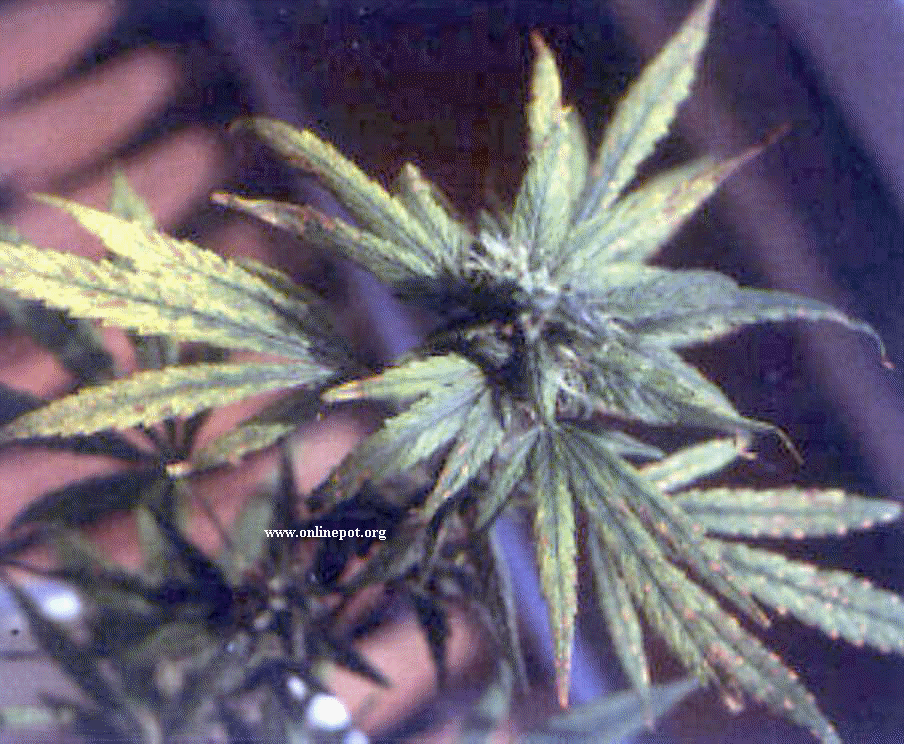
Figure 14.
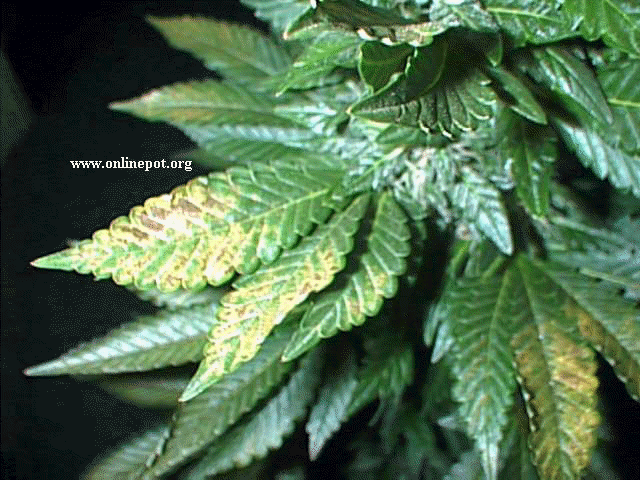
Figure 15.
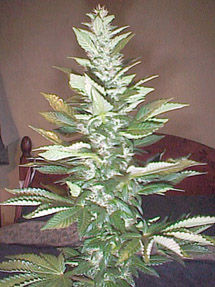
Figure 16.
Magnesium (Mg) Toxicity
Magnesium toxicity is rare and not generally exhibited visibly. Extreme high levels will antagonize other ions in the nutrient solution.
Zinc Deficiencies
Deficiencies appear as chlorosis in the inter-veinal areas of new leaves producing a banding appearance as seen in figure 18. This may be accompany reduction of leaf size and a shortening between internodes. Leaf margins are often distorted or wrinkled. Branch terminals of fruit will die back in severe cases.
Also gets locked out due to high pH. Zn, Fe, and Mn deficiencies often occur together, and are usually from a high pH. Don’t overdo the micro-nutrients- lower the pH if that’s the problem so the nutrients become available. Foliar feed if the plant looks real bad. Use chelated zinc. Zinc deficiency produces “little leaf” in many species, especially woody ones; the younger leaves are distinctly smaller than normal. Zinc defeciency may also produce “rosetting”; the stem fails to elongate behind the growing tip, so that the terminal leaves become tightly bunched.
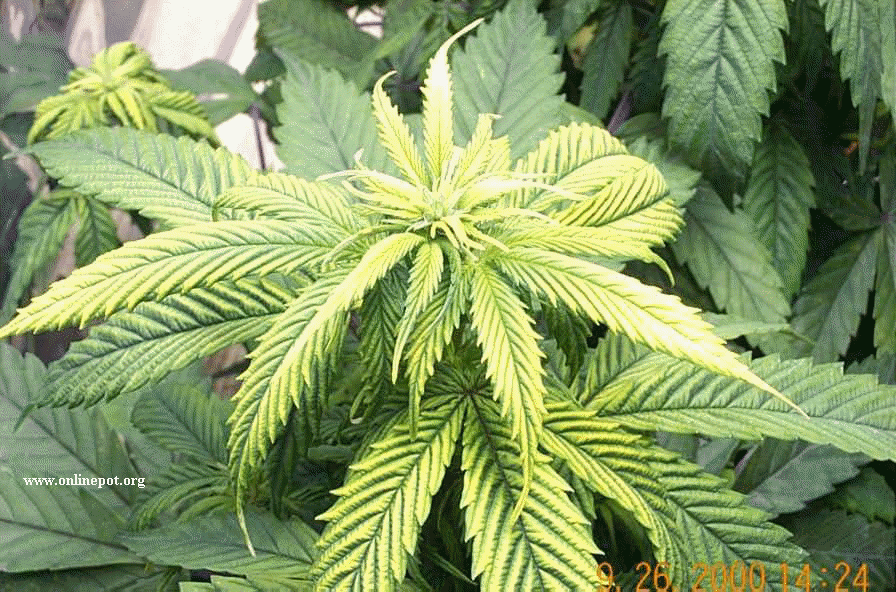
Figure 17.
Zinc Toxicity
Excess Zinc is extremely toxic and will cause rapid death. Excess zinc interferes with iron causing chlorosis from iron deficiency. Excess will cause sensitive plants to become chlorotic.
Sulphur (S) deficiency
The initial symptoms are the yellowing of the entire leaf including veins usually starting with the younger leaves. Leaf tips may yellow and curl downward. Sulfur deficiencies are light green fruit or younger leaves with a lack of succulence. Elongated roots and woody stem. Although it’s hard to see in figure 19, the upper stems of this plant are purple. Although many varieties of cannabis do get purplish stems, the trait generally extends the entire length of the plant’s stem, and not just near the top as in this specimen.
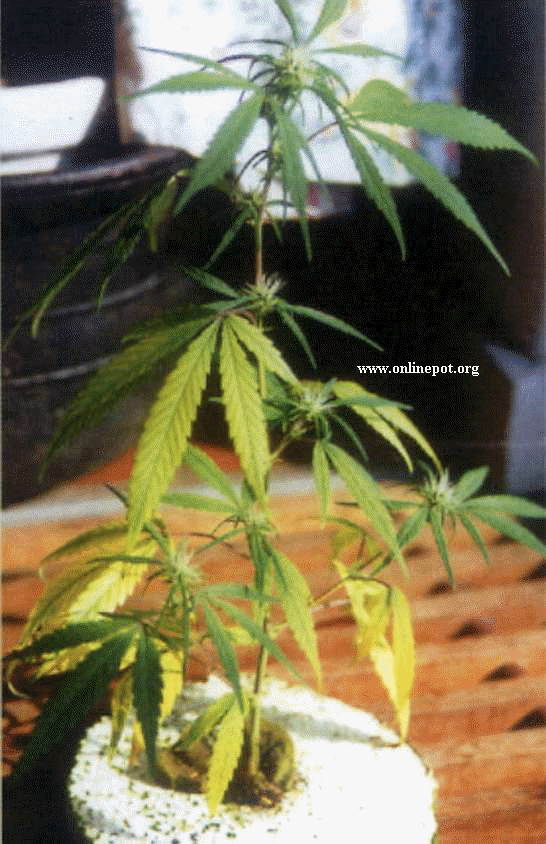
Figure 18.
Sulphur Toxicity
Leaf size will be reduced and overall growth will be stunted. Leaves yellowing or scorched at edges. Excess may cause early senescence.
Iron (Fe) deficiency
Pronounced interveinal chlorosis similar to that caused by magnesium deficiency but on the younger leaves.
Leaves exhibit chlorosis (yellowing) of the leaves mainly between the veins, starting with the lower and middle leaves.
Caused by factors that interfere with iron absorption of roots: over irrigation, excessive soluble salts, inadequate drainage, pests, high substrate pH, or nematodes. This is easily corrected by adding an iron supplement with the next watering.
Fe is unavailable to plants when the pH of the water or soil is too high. If deficient, lower the pH to about 6.5 (for rockwool, about 5.7), and check that you’re not adding too much P, which can lock up Fe. Use iron that’s chelated for maximum availability. Read your fertilizer’s ingredients – chelated iron might read something like “iron EDTA”. To much Fe without adding enough P can cause a P-deficiency.
Note that when adding iron to the solution, it is often necessary to not use fertilizer for that watering. Iron has a tendency of reacting with many of the components of fertilizer solutions, and will cause nutrient lockup to occur. Read the labels of both the iron supplement and the fertilizer you are using before you attempt to combine the two.
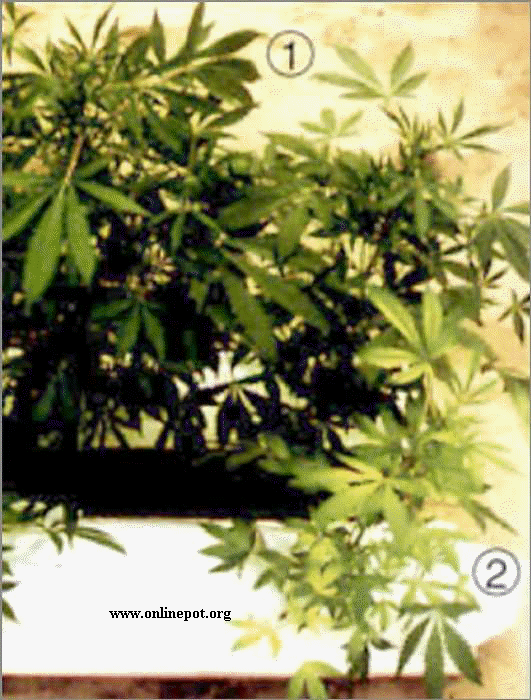
Iron Toxicity
Excess accumulation is rare but could cause bronzing or tiny brown spots on leaf surface. Manganese is involved in the oxidation-reduction process in the photosynthetic electron transport system. Biochemical research shows that this element plays a structural role in the chloroplast membrane system, and also activates numerous enzymes.
Here Are 2 Other Pages On Marijuana Plant Nutrient Disorders To
Help You Diagnose Your Plants Problem Besides This Page With Photos
Germination- By The Green Brothers Band